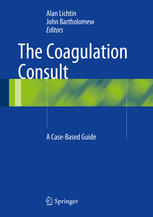

Most ebook files are in PDF format, so you can easily read them using various software such as Foxit Reader or directly on the Google Chrome browser.
Some ebook files are released by publishers in other formats such as .awz, .mobi, .epub, .fb2, etc. You may need to install specific software to read these formats on mobile/PC, such as Calibre.
Please read the tutorial at this link: https://ebookbell.com/faq
We offer FREE conversion to the popular formats you request; however, this may take some time. Therefore, right after payment, please email us, and we will try to provide the service as quickly as possible.
For some exceptional file formats or broken links (if any), please refrain from opening any disputes. Instead, email us first, and we will try to assist within a maximum of 6 hours.
EbookBell Team

0.0
0 reviewsThere have been many changes in the field of coagulation during the past decade. New concepts of epidemiology of risk factors for thrombosis now help clinicians predict who is more likely to form clots after surgery, or after being placed on oral contraceptives. New anticoagulants have the potential to redefine how patients with atrial fibrillation and venous thrombosis are managed. There are new forms of recombinant clotting factors which have changed our approach to hypofibrinogenemia and von Willebrand’s disease. Newer antiplatelet agents are available and their use in patients receiving cardiac stents has mushroomed. The management of thrombosis in the setting of pregnancy has changed over the past decade, as well as the way clinicians approach women with multiple miscarriages. An entire new class of compounds, the thrombopoietins, are available to treat individuals with immune thrombocytopenic purpura (ITP).
The Coagulation Consult covers major topics of interest to hematologists who are asked to consult on individuals with coagulation related diseases, and encompasses the field’s most recent developments. This “case-directed” book describes state-of-the-art approaches to patients with bleeding and clotting disorders, as well as laboratory tests for coagulation. Chapters include different vignettes, focus on typical clinical consult questions, and lay out specific types of treatment. Practicing clinicians being confronted with coagulation consult students, residents, fellows and attending physicians will find this unique text an invaluable resource for some of the newer areas of coagulation science, therapy and pharmacology.